
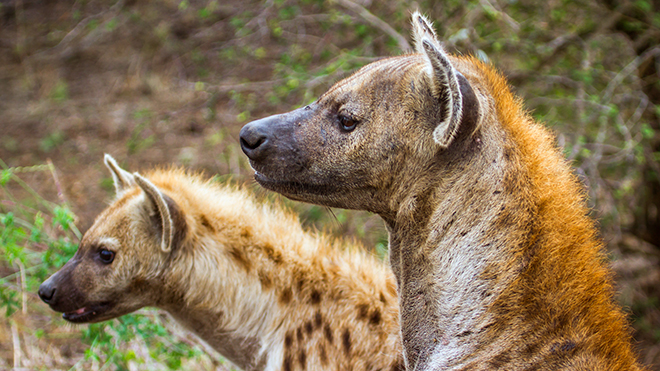
Co-authors Virginia Hayssen and Teri Orr begin each chapter of their forthcoming book, Mammalian Reproduction: A Female Perspective, with a story about the spotted hyena, whose unique physiology and fascinating mating patterns compel us to take a closer look at what we think we know about reproduction.

/ Published October 5, 2016
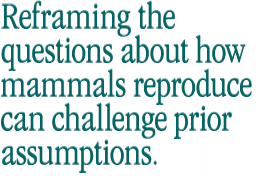
“Perhaps more than any other class of organisms on Earth, female mammals possess extraordinary control over their reproduction,” begins the introduction to Mammalian Reproduction: A Female Perspective, a forthcoming book co-written by Virginia Hayssen and Teri Orr. Not only do female mammals control gestation and lactation, some even have the ability to choose the sex of their babies. For too long, this field of study has been influenced by a male-centric view, the authors say, one that their book attempts to expose—and challenge.
Once Virginia Hayssen, a professor of biological sciences at Smith, begins discussing the reproductive adaptations developed by different mammals, she emanates an irrepressible sense of wonder. Facts pour out like a faucet turned on full-force. Nine-banded armadillos almost always give birth to identical quadruplets. The spotted hyena mates and gives birth through its large, distinctive “clitoris.” Hooded seals wean their pups after only four days. Walrus babies develop a white coat, which they shed and eat in utero; they are then born with a dark coat. And the multiple fetuses of pronghorn antelopes kill each other in the womb, a process called siblicide. Hayssen could go on. “There are plenty of fascinating stories,” she says. “It’s just wow, wow, wow, wow.”
Intriguing facts aside, what Hayssen and Orr, now a postdoctoral researcher at the University of Utah, have sought to do in their book, is put those facts into a larger context. The “female perspective” fosters that goal.
So why hasn’t this been done before?
Research has been hampered by an adherence to Western- and human-centric interpretations. Hayssen and Orr found that many of the stories specific to individual taxa lacked the synthesis or integration needed to fully demonstrate the diversity and scope of reproductive strategies in female mammals. That has been, in part, because research has typically involved domesticated or laboratory mammals. Studying mammals in their natural habitat can be cost-prohibitive, complex, time-consuming, logistically challenging or impossible. But ultimately, the ways in which reproduction is integrated into the biology of females cannot be analyzed fully in captive animals, says Hayssen.
As Smith Associate Professor Annaliese Beery has noted in her research, until the mid-20th century females were largely ignored in both biomedical and field research. Most studies focused on males or male behavior—not just as research subjects but also in the use of gender-loaded or value-laden terminology that could prejudice our views of reproduction. For example, certain terms—such as “miscarriage”—reflect inherent biases that are so ingrained we don’t even realize we have them. “If you take a female-centric framework, ‘miscarriage’ is an inaccurate term,” says Hayssen. “The female is not miscarrying anything,” which implies fault. Her body is rejecting an embryo that is not viable, and embryo rejection is a common part of mammalian reproduction, she says.
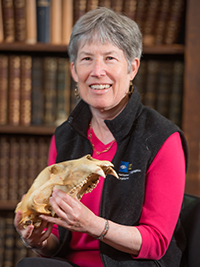
Virginia Hayssen
Hayssen began studying mammals more than 30 years ago as a graduate student—a time when she wouldn’t have even understood that the field was lacking a female perspective given the accepted interpretations of mammalian gender behaviors and lack of research into that area. In 2013 she and Orr, then a postdoctoral researcher at the University of Massachusetts Amherst, began what Hayssen describes as a fun and energizing collaboration. Hayssen had proposed a book on mammalian reproduction to Johns Hopkins University Press; the publisher was interested but suggested developing a unique angle to add to the existing body of literature.
Hayssen sought the advice of Orr. They revised the proposal, had it accepted and set out on what became a three-year collaboration. They each read widely on the topic, then met once a month to compare notes. By happenstance, they engaged with different material, leading to new and sometimes surprising ideas. Each aimed to write 5,000 words per month, continually building upon what they had done. A year later, 120,000 words had emerged, and Mammalian Reproduction: A Female Perspective was born, due out in 2017.
In addition to thoroughly enjoying their “wonderful conversations,” Hayssen found their individual perspectives to be particularly valuable. “We are two different generations, so we had completely different exposure to the topic and a different sense of historical relevance—where the field has been versus where it is going. We merged those two perspectives,” Hayssen says.
Part of that also involved another merger—viewing reproduction as the core of physiology. Even texts as current as 2015, says Hayssen, isolate physiological systems from reproduction. As an example, Orr notes that any discussion of the diaphragm typically focuses only on its role in respiration. But divorcing reproduction from the discussion overlooks the fact that the diaphragm is an important bearing-down muscle during labor. “Reproduction is not secondary to other physiology,” emphasizes Orr. “All female bodily functions are in service of reproduction.”
Their book also integrates physiology and ecology. Bridging the physiological view (which is concerned with exploring what triggers birth or maintains lactation) with the ecological view (which takes into account factors like litter size and the number of litters per year related to available resources) isn’t an easy task. “Those two areas are miles apart from each other in terms of the fundamental information they need to understand,” says Hayssen. Alone they are complex fields. To bridge the gap between them requires reframing the questions.
Using different approaches to explore how mammals reproduce can challenge prior assumptions—those that may be influenced by cultural perceptions and value judgments. For example, consider the use of the word “fertilization” versus “conception.” “Fertilization” is male active, regarding the female as nothing more than a receptacle for sperm, Hayssen says. “But ‘conception’ is not male active/female passive.” In fact, females are active participants in all aspects of reproduction. A look at horses—just one example among many—is evidence that females are not at all a passive part of mating. When a mare is in heat, she puts on a display called “clitoral winking,” an overt sign that she is actively seeking a stallion.
To challenge prevailing notions, the authors began each of the book’s 15 chapters with a story about the spotted hyena, whose enlarged genitalia is often referred to as a phallus. “From the female perspective, it’s not at all a phallus. She has this appendage, which happens to be bigger than a male’s.” Why do we give it male terminology?
The use of the hyena was strategic, says Orr, not only because it underscores a male and anthropomorphic bias, but also because it serves as a perfect foil for many assumptions about female mammals. “Spotted hyenas have an obviously female dominant social hierarchy and female morphology.”
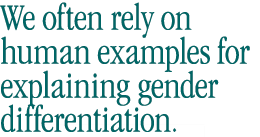
Using a human-centric lens to study other mammals is especially unsuitable for examining conception and gestation. For example, Hayssen points to how we typically discuss the menstrual cycle. While the idea of a “cycle” is the norm for humans, that pattern really is not present in other species, she says. In the wild, all other mammals don’t cycle, cycle, cycle. For example, tammar wallaby females are pregnant 364 days each year, and the only nonpregnant day is the one in which they give birth. A weasel will mate with multiple males, store sperm and then ovulate (or not) 72 to 96 hours after mating. The plains viscacha will have 50 to 850 ova at a time and up to seven conceptions, which will be implanted and developed over a period of 30 days. By 90 days all but the most viable embryos are resorbed, and the litter size is twins.
We also often rely on human examples for explaining gender differentiation, which varies widely in mammals, many of whom don’t have a single XY chromosomal pair that determines gender.
The authors relied on their previous research work on marsupials, monkeys, whales, bats, squirrels, rabbits, wolves and foxes to build the foundation of mammals to include in the book. But the hundreds of mammals covered essentially chose themselves because of their unique characteristics and behaviors, says Hayssen.
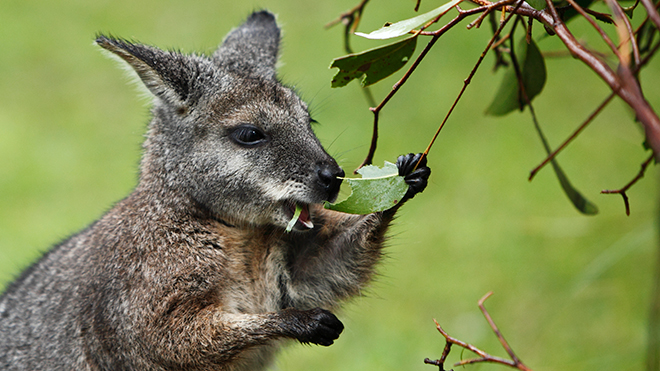
Using a human-centric lens to study other mammals is especially unsuitable for examining conception and gestation. Tammar wallaby females are pregnant 364 days each year; the only nonpregnant day is the one in which they give birth.
Fifteen students in Hayssen’s spring 2016 course, BIO 351 Topics in Evolutionary Biology: Evolution of Mammalian Reproduction—A Female Perspective, read the book’s early manuscript for class, each selecting a mammal to research and report on. One criterion was that the students had to find at least 15 citations involving reproduction for that mammal. Students were surprised to discover how little we actually know about mammalian reproduction, says Hayssen—in part because they were new to the topic, but also because it is still an emerging field. Hayssen says this presents plenty of opportunities for this work to go forward. “Many times during the seminar we would say, ‘Well there’s a dissertation topic, and there’s a dissertation topic....”
And while Orr and Hayssen say their goal was not so lofty as to change clinical procedures, they do hope that their work demonstrates the need to further explore—in a more objective way—how reproduction fits into the lives of mammals and how the biology of mammals affects their reproductive systems.
Risking an unconventional route can sometimes lead to new advances and innovations in our thinking. Says Orr, “If you try to put things into an existing box you might end up spending a lot of time explaining rather than just removing the box.”














